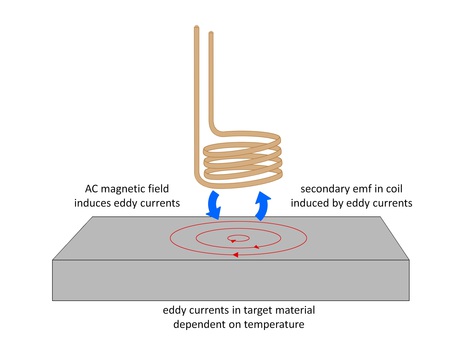New technology inspired by old science

A 165-year-old scientific principle is behind the development of a new, non-contact way to measure high temperatures for applications ranging from foundries, machining and food processing to use on aircraft engines and braking systems. The technique has been used over temperature ranges of several hundred degrees Celsius with accuracy of 1°C and could replace existing contact methods such as thermocouples and the use of infrared.
Researchers at The Technology Partnership (TTP) worked from the principle that applying an alternating current to a coil will induce eddy currents in nearby metallic objects - an effect commonly used in proximity sensors and non-destructive testing. TPP has exploited the fact that the flow of eddy currents is also dependent on the material’s temperature and can be used to provide a completely new approach to non-contact temperature sensing.
Using a special coil arrangement, sensing methodology and algorithm to detect and measure the induced eddy currents, the researchers have been able to implement inductive temperature sensing of targets in a wide range of challenging environments, through metal barriers and even in applications where the geometry of the target material is unknown.
“Inductive temperature sensing is ideal for applications where contact methods are not reliable and where lack of line-of-sight access, variable emissivity or high cost limit the use of infrared techniques,” said Dr David Pooley, a senior consultant at TTP. “And because of the simplicity of applying the technology in practical environments, it could also be used in low-cost consumer applications.”
Eddy currents were first discovered by French physicist Leon Foucault in 1851, following the discovery of electromagnetic induction by Michael Faraday in 1831. But it was not until the 1930s that eddy current technology started to be used for industrial applications.
“It’s very exciting to take a 165-year-old principle and discover a completely new range of applications for it,” says Dr Pooley. “We are continuing our practical trials to refine the process and explore new applications, and we are already getting a lot of interest from potential partners to commercialise the technology and take it to market.”
Complete snack and confectionery line on show
TNA Solutions will spotlight complete snack and confectionery line solutions at Gulfood...
$340,000 safety spend after fruit packing injury
A fruit packing company has pledged to spend $340,000 to improve health and safety outcomes after...
FMCG Industry Solutions acquires Ozflow Australia
FMCG Industry Solutions has acquired Ozflow Australia, a supplier of hygienic-by-design...













